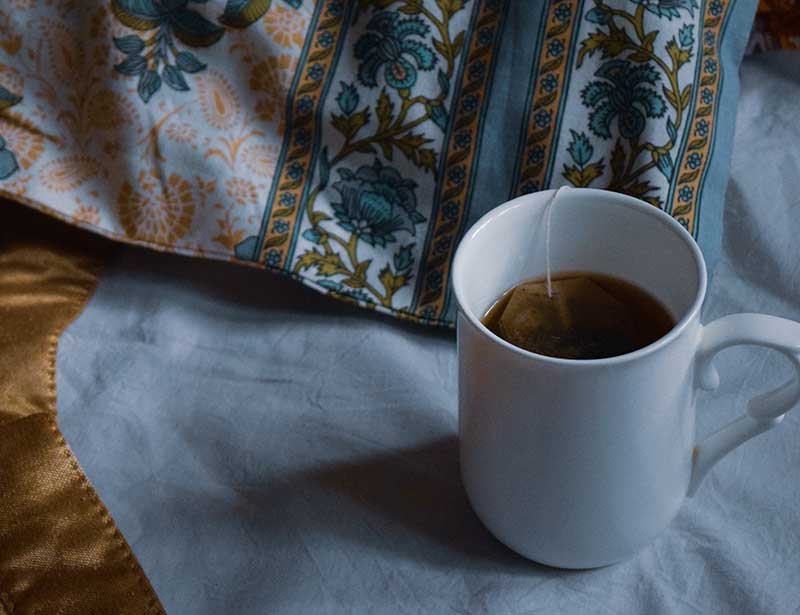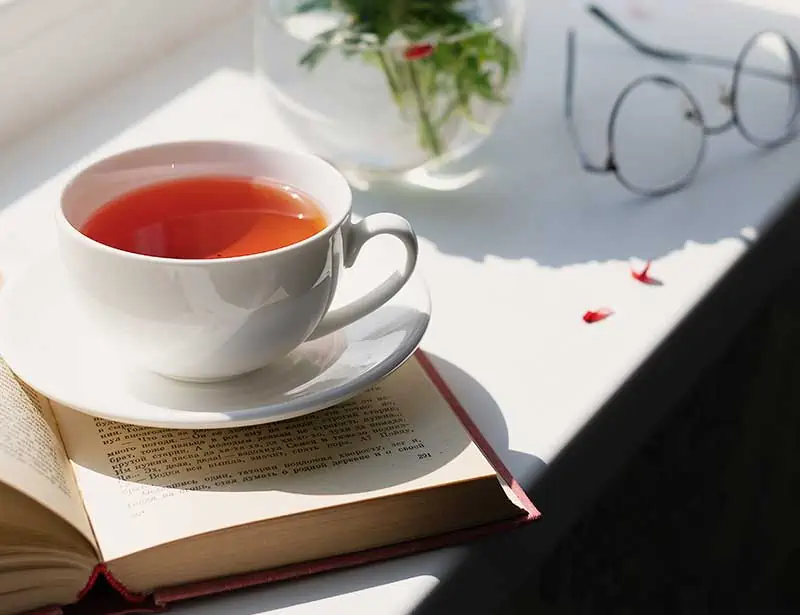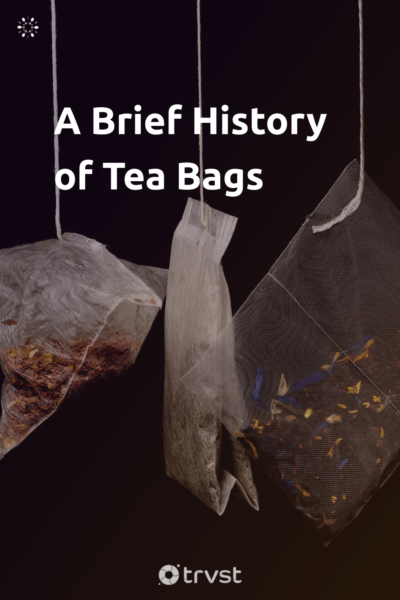When Were Tea Bags Invented? The History of Tea Bags
Having a cup of tea is one of those things that many people use to relax. Whether that's having it alone or in the company of other tea lovers, people enjoy their tea in different ways - from the brewing method down to the choice of flavor.
Many tea connoisseurs enjoy making their cups of tea using the traditional method of steeping tea leaves. Meanwhile, many others have fully taken on the way of the tea bag.
After all, one of the reasons for its invention was to bring about convenience—the origin of tea dates centuries back. However, we can trace the history of the tea bag back over 100 years. This invention changed the tea brewing process and how people enjoy a single cup of tea.
Love tea? You might also like our compilation of the best tea quotes.
What are Tea Bags?
Tea bags are small sealed bags, porous in nature, holding either whole or ground tea leaves. Manufacturers design these bags to aid immersion in water for steeping tea. This could be with the intention of making a cup of tea or a whole pot.
Many tea bags have a string attached to them to aid the brewing process. Producers also include a paper tag, which they attach to the end of the string, which carries the brand name.
While for the unfamiliar, tea bag producers will also often include brewing instructions on the package. In this article, we'll examine tea bag history, from a more convenient way to steep loose-leaf tea, to huge popularity, through some dissent in more recent times due to plastic waste.
History of the Tea Bag
We can trace the history of the first modern tea bags to the United States over 100 years ago. There are two distinct accounts of the invention of the tea bag, with both starting in the 1900s.
The first two names involved in the invention of the tea bags are Roberta Lawson and Mary Molaren. The third name, which is more widespread in terms of the history of tea bags, is Thomas Sullivan, a New York tea merchant.
The Tea Leaf Holder Patent
Before tea bags became widely popular, two women from Milwaukee, Wisconsin, Roberta C Lawson and Mary Molaren, had filed a patent in 1901. This was for a tea leaf holder.
They established a way for people to make a cup of tea without needing to include a teapot. They believed that the tea leaf holder would solve the waste problem by ensuring people use the required amount of leaves.
They also mentioned in their patent application that brewing large quantities of tea leaves often led to stale leaves. As a result, their goal was to create something that would ensure a convenient steeping process in hot water and freshly brewed tea. This meant skipping the then-regular process of tea brewing in a large teapot.
Their invention was made of an open mesh woven fabric made of cotton thread. This stitched mesh fabric held the tea leaves.
How Was the Tea Bag Accidentally Invented?
The more popular account of the tea bag invention is that of New York tea and coffee importer Thomas Sullivan. Although, by examining the historical accounts, we can see that Sullivan played more of a role in popularising tea bags.
In 1908, Thomas Sullivan began sending out tea samples to his customers. He filled silk pouches with tea and sent these samples out. The reason was that Thomas was looking for a less expensive and more convenient way to send his customers small samples of fine teas. Tin was popular then but was heavy and would contribute to shipping expenses. So eventually, he settled for small silken bags.
The following events led to him accidentally creating a version of tea bags. Back then, people used metal infusers for brewing. So, when the merchant sent the pouches, Sullivan's customers assumed they were meant to put the bags in boiling water.
So, instead of removing the tea leaves, they simply put the silken bags filled with tea in water. The customers found this convenient, and the tea bag didn't necessarily affect the tea flavors.
Later, people wanted something better because they realized the silk mesh bag was too fine. Then, Sullivan established tea bags made from gauze to replace silk bags.
This material became popular in the 1920s, and commercial production blew up. This especially became popular in the United States, and many other tea companies started imitating this. Tea bag producers made two sizes—a small one for cup use and a large one for teapots.
Purpose of Tea Bags
Regardless of the two accounts of the origin of the tea bag, it's clear that this invention served two primary purposes—the first being convenience and the second related to taste. Convenience-wise, tea bags made it easy for tea drinkers to quickly make a single cup of tea simply because each pouch contains the necessary leaf tea amount.
This innovation eliminated the need to make large quantities of tea. Also, it helped to reduce wasting tea leaves. Secondly, some people believed that tea would taste better when people removed the leaves from the drink after brewing.

The Timeline of the Tea Bag Evolution
The tea bag has gone through various stages in history. Each of these stages has led to refinements of this invention. From how manufacturers produce it to various designs and packaging styles. Below are some of the highlights in the evolution of the tea bag:
The 1930s
Around this time, manufacturers were already producing different shapes and materials for tea bags. Some of the tea bag materials they were working with included gauze, which Sullivan popularised. Some others included cheesecloth and perforated paper.
The most popular and celebrated became paper fiber bags out of all these. Initially, people made these tea bags through hand sewing. Afterward, the 30s brought about machine production.
A notable moment in this era is linked to William Hermanson, a Technical Papers Corporation founding member. He invented and patented heat-sealed paper fiber bags. This significantly changed the way manufacturers produced tea bags.
The relevant Crush, Tear, Curl (CTC) method came about around 1931. William McKercher invented a technique that enabled machines to cut tea leaves into fine ground particles.
This was a significant change from the method of twisting leaves. It also revolutionized the production of black tea. The CTC method made filling tea bags with granules easy for tea companies. It also translated to a faster brewing time for people to enjoy their drinks. Today, we can see the CTC method in around 95% of black teas.
The 1940s
By the 1940s, in 1944 precisely, the Tetley tea brand revised the tea bag shape. Previously, manufacturers made tea bags in sack-style pouches. However, Tetley Tea was the first company to create the square or rectangular shape of flat tea bags as we know them.
Eventually, the company started using a machine that allowed them to stitch more bags every minute, revolutionizing how we made tea bags. Their processes were also much faster than tea bags' initial hand-sewing method.
At the same time, the growth in the commercial production of tea meant they could sell more products in response to the constantly growing demand for tea bags. This was primarily due to the convenience and waste prevention qualities that came with tea bags. As a result, loose-leaf tea began to decline in popularity.
The 1950s
There was another innovation within the tea bag industry to come as time went on. The Lipton Tea Company created a "flo-thru" bag in 1952. They created this four-sided bag with the intention of people using mugs to brew. As the name suggests, the bag aided the water flow into the bag during steeping. The design also easily allowed the leaves to expand while in the bag. What did all of these lead to?
With the desired infusion time, the water could come in contact and flow through the tea leaves. This allowed tea lovers to enjoy the tea flavors better than designs that limited water contact with the tea. A shorter and faster infusion time produced stronger and richer tea tastes.
Regarding the tea tags, the Lipton company is often credited with being the first to use paper tags. The company used the tags to print instructions for brewing and added a little more convenience as people became accustomed to bobbing their tea bags in the cup.
The 1990s
In 1992, Tetley rose again to contribute to the evolution of the tea bag. The company launched the round tea bag during this period. Their marketing efforts led to popularising the round tea bag, which was a significant shape change.
These tea bags from Tetley were suitable for large tea mugs because they contained more tea. The classic square tea bags came with strings and paper tags. However, Tetley's round design got rid of these as they contributed to waste.
Another major invention during the 90s came from Brooke Bond. This is the parent company of PG Tips, a tea brand in the United Kingdom. In 1997, this company created the pyramid bags as we know them today. Pyramid tea bags act like a teapot, providing more room for concealed teas to move around than the previous flat designs.
It was also better suited for teapots and big mugs because of its shape. This meant people could make more tea and produce their desired infusion. A pyramid tea bag design especially helps when making tea for more than one person.
Tea Bags Today
There are various types of modern tea bags these days. Due to sustainable and eco-friendly reasons, the market is filled with reusable tea bags that you can buy. The world is also seeing a rise in specialty tea, which is a premium version of loose-leaf tea from single tea gardens.
Apart from this, companies produce tea in different pouches. They use materials like cotton muslin, filter paper, or food-grade plastic. Also, some brands manufacture silk bags as a premium or high-end version. Packaging options are available, such as tins, single-use packets, and general packets.
Cotton strings are a popular addition to tea bags today. They serve the purpose of making steeping easier and also enable easy removal after steeping. Another recurrent theme is paper tags. Paper tags are popular because they reflect the brand name and identity. However, some round bags like those Tetley popularised don't have tags or strings.
Although brands have implemented major changes over the years, some still embrace specific processes. For instance, Lipton's essential bag has not changed much over the years. This also includes the amount of tea contained in each bag.
The tea bag has gone through several stages and processes since its inception. Many people praise it for its ease of use. However, there are still many others that have refused to accept this invention fully.
Meanwhile, a new crop of organic and sustainable tea brands, often championing teabag-less loose-leaf tea, points toward more ethical production for the environment.
The Rejection of the Tea Bag

The way the American population received tea bags was drastically different from the British population. Americans welcomed this innovation with open arms, while the British didn't immediately warm up to it. Also, many tea connoisseurs struggled, and some still do, with accepting this way of making the drink. Some of the reasons for this rejection include:
- Tea bags limit the space for the leaves to move freely. This translates to losing some of the flavors and not benefiting from all the nutrients. These experts believe that the bags limit the experience of enjoying high-quality tea.
- The experts believe that the granules of tea bags can't be compared to whole-leaf tea. The CTC method, for instance, brought about tea granules. This made it easy to fit them in the bags. However, loose tea allows the flavors and benefits of the tea to release into the liquid thoroughly.
Tetley played a role in making tea bags popular in the United Kingdom. This was a great success; over the years, Britons have embraced these bags. A survey conducted in 2020 revealed that Britons use 61 billion tea bags every year.
Furthermore, as more people become concerned with our global plastic waste problem, there's a move away from tea bags that contain plastic. However, many mass-produced bags do include a thin layer of plastic to aid their strength when wet.
Additionally, there's a throwback occurring as people opt for loose-leaf teas and reusable strainers without needing a bag at all.
You can read more about plastic in tea bags: Plastic Tea Bags - Does Yours Contain Plastic?
Conclusion
The evolution of tea bags has come a long way over the years. Today, they continue to serve their purpose of offering a convenient way to have tea. They come in various sizes, shapes, and materials. Beyond drinking, people also use tea bags for dark eye circles, absorbing odors, and soothing sunburns.
Jen’s a passionate environmentalist and sustainability expert. With a science degree from Babcock University Jen loves applying her research skills to craft editorial that connects with our global changemaker and readership audiences centered around topics including zero waste, sustainability, climate change, and biodiversity.
Elsewhere Jen’s interests include the role that future technology and data have in helping us solve some of the planet’s biggest challenges.

